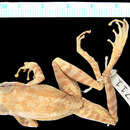Description
provided by AmphibiaWeb articles
M 40-45 mm, F 40-45 mm. Weakly expressed outer dorsolateral folds, no inner dorsolateral folds, interocular tubercles, supraocular spines, nor heel tubercles. Dorsal skin smooth. Colouration variable but most individuals with a distinct light stripe along the upper lip.Similar species: Gephyromantis redimitus and G. cornutus also call along brooks in forest, but have single subgular vocal sacs and mostly two black tubercles between the eyes. Tibiotarsal articulation of G. redimitus reaches only beyond the eye. G. leucomaculatus has a smaller inner metatarsal tubercle, lacks the light band along the upper lip, and calling males are not found along brooks. It is especially similar to G. zavona.Taken with permission from Glaw and Vences (2007).
Raxworthy, C. and Vences, M. (2008). Gephyromantis granulatus. In: IUCN 2008. 2008 IUCN Red List of Threatened Species. www.iucnredlist.org. Downloaded on 18 March 2009.
- author
- Miguel Vences
- author
- Frank Glaw
Distribution and Habitat
provided by AmphibiaWeb articles
Andapa, Andrakata, Benavony, Lokobe, Manongarivo, Marojejy, Montagne d’ Ambre, Nosy Be, Tsararano, Tsaratanana (Andampy campsite). It occurs from near sea level up to 900m (Raxworthy and Vences 2008).
- author
- Miguel Vences
- author
- Frank Glaw
Life History, Abundance, Activity, and Special Behaviors
provided by AmphibiaWeb articles
Habits: Males call at night from the vegetation, 0.5-2 m above the ground, close to streams. In intact and degraded rainforest as well as in secondary vegetation.Calls: A long regular series of unharmonious notes.
- author
- Miguel Vences
- author
- Frank Glaw
Life History, Abundance, Activity, and Special Behaviors
provided by AmphibiaWeb articles
This species is listed as least concern in view of its wide distribution, tolerance of a degree of habitat modification, presumed large population, and because it is unlikely to be declining fast enough to qualify for listing in a more threatened category (Raxworthy and Vences 2008).
- author
- Miguel Vences
- author
- Frank Glaw
Gephyromantis granulatus: Brief Summary
provided by wikipedia EN
Gephyromantis granulatus, commonly known as the grainy Madagascar frog, is a species of frog in the family Mantellidae. It is endemic to Madagascar. Its natural habitats are subtropical or tropical moist lowland forests, plantations, and heavily degraded former forest.
- license
- cc-by-sa-3.0
- copyright
- Wikipedia authors and editors

